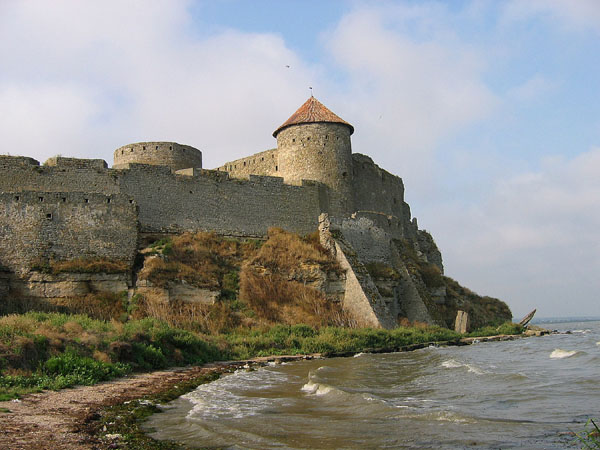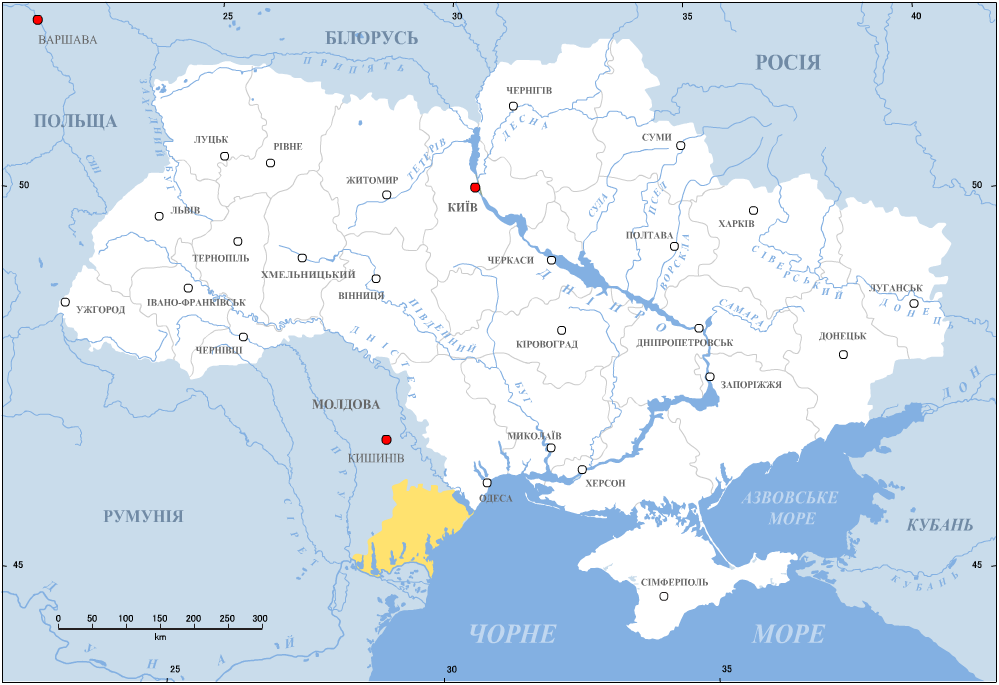|
Akkerman Oblast
Izmail Oblast (; ro, Regiunea Ismail) (7 August 1940 — 15 February 1954) was an oblast in the Ukrainian SSR, roughly corresponding to the historical region of Budjak. It had a territory of . The oblast was organized on 7 August 1940 on the territory, known as Budjak or southern Bessarabia, occupied by the Soviet Union from Romania. It was originally known as Akkerman Oblast () until 1 December 1940, i.e. before the oblast center was moved from Akkerman to Izmail. The oblast was administratively subdivided into 13 raions. On 15 February 1954, the oblast was liquidated, and its territory was included in Odessa Oblast. The current area is now divided into two municipalities (Izmail and Bilhorod-Dnistrovskyi) and nine raions; these cover and in 2015 had a combined population of 592,842. See also *Izmail Raion External links Akkerman Oblast(Handbook on history of the Communist Party and the Soviet Union) Decree of the Presidium of the Supreme Council of USSR of February 15, 19 ... [...More Info...] [...Related Items...] OR: [Wikipedia] [Google] [Baidu] |
Ukrainian SSR
The Ukrainian Soviet Socialist Republic ( uk, Украї́нська Радя́нська Соціалісти́чна Респу́бліка, ; russian: Украи́нская Сове́тская Социалисти́ческая Респу́блика, group=note), abbreviated as the Ukrainian SSR, UkrSSR, or UkSSR, and also known as Soviet Ukraine, was one of the constituent republics of the Soviet Union from 1922 until 1991. In the anthem of the Ukrainian SSR, it was referred to simply as ''Ukraine''. Under the Soviet one-party model, the Ukrainian SSR was governed by the Communist Party of the Soviet Union through its republican branch: the Communist Party of Ukraine. The first iterations of the Ukrainian SSR were established during the Russian Revolution, particularly after the Bolshevik Revolution. The outbreak of the Ukrainian–Soviet War in the former Russian Empire saw the Bolsheviks defeat the independent Ukrainian People's Republic, after which they fou ... [...More Info...] [...Related Items...] OR: [Wikipedia] [Google] [Baidu] |
Soviet Occupation Of Bessarabia
The Soviet invasion and occupation of Bessarabia and Northern Bukovina took place from June 28 to July 3, 1940, as a result of an ultimatum by the Soviet Union to Romania on June 26, 1940, that threatened the use of force. Bessarabia had been part of the Kingdom of Romania since the time of the Russian Civil War and Bukovina since the dissolution of Austria-Hungary, and Hertsa was a district of the Romanian Old Kingdom. Those regions, with a total area of and a population of 3,776,309 inhabitants, were incorporated into the Soviet Union. On October 26, 1940, six Romanian islands on the Chilia branch of the Danube, with an area of , were also occupied by the Soviet Army. The Soviet Union had planned to accomplish the annexation with a full-scale invasion, but the Romanian government, responding to the Soviet ultimatum delivered on June 26, agreed to withdraw from the territories to avoid a military conflict. The use of force had been made illegal by the Conventions for the Defin ... [...More Info...] [...Related Items...] OR: [Wikipedia] [Google] [Baidu] |
Odessa Oblast
Odesa Oblast ( uk, Оде́ська о́бласть, translit=Odeska oblast), also referred to as Odeshchyna ( uk, Оде́щина) is an administrative divisions of Ukraine, oblast (province) of southwestern Ukraine, located along the northern coast of the Black Sea. Its administrative centre is the city of Odesa ( uk, Одеса). Population: The length of coastline (sea-coast and estuaries) reaches , while the state border stretches for .Tell about Ukraine. Odessa Oblast 24 Kanal (youtube). The region has eight seaports, over of vineyards, and five of the biggest lakes in Ukraine. One of the largest, Yalpuh Lake, is as large as the city of Odesa itself. History Evidence of the earliest inhabitants in this area comes from the settlements a ...[...More Info...] [...Related Items...] OR: [Wikipedia] [Google] [Baidu] |
Oblast
An oblast (; ; Cyrillic (in most languages, including Russian and Ukrainian): , Bulgarian: ) is a type of administrative division of Belarus, Bulgaria, Kazakhstan, Kyrgyzstan, Russia, and Ukraine, as well as the Soviet Union and the Kingdom of Yugoslavia. Official terms in successor states of the Soviet Union differ, but some still use a cognate of the Russian term, e.g., ''vobłasć'' (''voblasts'', ''voblasts'', official orthography: , Taraškievica: , ) is used for regions of Belarus, ' (plural: ') for regions of Kazakhstan, and ''oblusu'' (') for regions of Kyrgyzstan. The term is often translated as "area", "zone", "province" or "region". The last translation may lead to confusion, because "raion" may be used for other kinds of administrative division, which may be translated as "region", "district" or "county" depending on the context. Unlike "province", translations as "area", "zone", and "region" may lead to confusion because they have very common meanings other t ... [...More Info...] [...Related Items...] OR: [Wikipedia] [Google] [Baidu] |
Izmail
Izmail (, , translit. ''Izmail,'' formerly Тучков ("Tuchkov"); ro, Ismail or ''Smil''; pl, Izmaił, bg, Исмаил) is a city and municipality on the Danube river in Odesa Oblast in south-western Ukraine. It serves as the administrative center of Izmail Raion, one of seven districts of Odesa Oblast, and is the only locality which constitutes Izmail urban hromada, one of the hromadas of Ukraine. In Russian historiography, Izmail is associated with the 18th century sacking of Ottoman fortress of Izmail by Russian general Alexander Suvorov. It is the largest Ukrainian port in the Danube Delta, on its Chilia branch. As such, Izmail is a center of the food processing industry and a popular regional tourist destination. It is also a base of the Ukrainian Navy and the Ukrainian Sea Guard units operating on the river. The World Wildlife Fund's ''Isles of Izmail Regional Landscape Park'' is located nearby. Population: History The fortress of Izmail, then known as , wa ... [...More Info...] [...Related Items...] OR: [Wikipedia] [Google] [Baidu] |
Bilhorod-Dnistrovskyi
Bilhorod-Dnistrovskyi ( uk, Бі́лгород-Дністро́вський, Bílhorod-Dnistróvskyy, ; ro, Cetatea Albă), historically known as Akkerman ( tr, Akkerman) or under different names, is a city, municipality and port situated on the right bank of the Dniester Liman (on the Dniester estuary leading to the Black Sea) in Odesa Oblast of southwestern Ukraine, in the historical region of Budjak. It also serves as the administrative center of Bilhorod-Dnistrovskyi Raion, one of seven districts of Odesa Oblast, and is the only locality which constitutes Bilhorod-Dnistrovskyi urban hromada, one of the hromadas of Ukraine. It is a location of a big freight seaport. Population: Nomenclature The city of Bilhorod-Dnistrovskyi is also referred to by alternative transliterations from Ukrainian as Bilhorod-Dnistrovsky or Bilhorod-Dnistrovskyy. ''Dnistrovsky'' was added to differentiate it from Bilhorod that was part of the Sloboda Ukraine and carried a similar name. ;Prev ... [...More Info...] [...Related Items...] OR: [Wikipedia] [Google] [Baidu] |
Budjak
Budjak or Budzhak (Bulgarian and Ukrainian: Буджак; ro, Bugeac; Gagauz and Turkish: ''Bucak''), historically part of Bessarabia until 1812, is a historical region in Ukraine and Moldova. Lying along the Black Sea between the Danube and Dniester rivers, this sparsely populated multi-ethnic 600,000-people region of is located in the southern part of historical Bessarabia. Nowadays, the larger part of the region is included in Ukraine's Odesa Oblast, while the rest is included in the southern districts of Moldova. The region is bordered to the north by the rest of Moldova, to the west and south by Romania, and to the east by the Black Sea and the rest of Ukraine. Name and geography Historically, Budjak was the southeastern steppe region of Moldavia. Bordered by the northern Trajan's Wall at its north end, by the Danube river and Black Sea to its south, by Tigheci Hills (just east of the Prut River) to the west, and Dniester River to the east, it was known as ''histori ... [...More Info...] [...Related Items...] OR: [Wikipedia] [Google] [Baidu] |
Bessarabia
Bessarabia (; Gagauz: ''Besarabiya''; Romanian: ''Basarabia''; Ukrainian: ''Бессара́бія'') is a historical region in Eastern Europe, bounded by the Dniester river on the east and the Prut river on the west. About two thirds of Bessarabia lies within modern-day Moldova, with the Ukrainian Budjak region covering the southern coastal region and part of the Ukrainian Chernivtsi Oblast covering a small area in the north. In the aftermath of the Russo-Turkish War (1806–1812), and the ensuing Peace of Bucharest, the eastern parts of the Principality of Moldavia, an Ottoman vassal, along with some areas formerly under direct Ottoman rule, were ceded to Imperial Russia. The acquisition was among the Empire's last territorial acquisitions in Europe. The newly acquired territories were organised as the Bessarabia Governorate of the Russian Empire, adopting a name previously used for the southern plains between the Dniester and the Danube rivers. Following the Crimean War ... [...More Info...] [...Related Items...] OR: [Wikipedia] [Google] [Baidu] |
Soviet Occupation Of Bessarabia And Northern Bukovina
The Soviet occupation of Bessarabia and Northern Bukovina took place from June 28 to July 3, 1940, as a result of an ultimatum by the Soviet Union to Romania on June 26, 1940, that threatened the use of force. Bessarabia had been part of the Kingdom of Romania since the time of the Russian Civil War and Bukovina since the dissolution of Austria-Hungary, and Hertsa was a district of the Romanian Old Kingdom. Those regions, with a total area of and a population of 3,776,309 inhabitants, were incorporated into the Soviet Union. On October 26, 1940, six Romanian islands on the Chilia branch of the Danube, with an area of , were also occupied by the Soviet Army. The Soviet Union had planned to accomplish the annexation with a full-scale invasion, but the Romanian government, responding to the Soviet ultimatum delivered on June 26, agreed to withdraw from the territories to avoid a military conflict. The use of force had been made illegal by the Conventions for the Definition of A ... [...More Info...] [...Related Items...] OR: [Wikipedia] [Google] [Baidu] |
Soviet Union
The Soviet Union,. officially the Union of Soviet Socialist Republics. (USSR),. was a transcontinental country that spanned much of Eurasia from 1922 to 1991. A flagship communist state, it was nominally a federal union of fifteen national republics; in practice, both its government and its economy were highly centralized until its final years. It was a one-party state governed by the Communist Party of the Soviet Union, with the city of Moscow serving as its capital as well as that of its largest and most populous republic: the Russian SFSR. Other major cities included Leningrad (Russian SFSR), Kiev (Ukrainian SSR), Minsk ( Byelorussian SSR), Tashkent (Uzbek SSR), Alma-Ata (Kazakh SSR), and Novosibirsk (Russian SFSR). It was the largest country in the world, covering over and spanning eleven time zones. The country's roots lay in the October Revolution of 1917, when the Bolsheviks, under the leadership of Vladimir Lenin, overthrew the Russian Provisional Government ... [...More Info...] [...Related Items...] OR: [Wikipedia] [Google] [Baidu] |
Romania
Romania ( ; ro, România ) is a country located at the crossroads of Central Europe, Central, Eastern Europe, Eastern, and Southeast Europe, Southeastern Europe. It borders Bulgaria to the south, Ukraine to the north, Hungary to the west, Serbia to the southwest, Moldova to the east, and the Black Sea to the southeast. It has a predominantly Temperate climate, temperate-continental climate, and an area of , with a population of around 19 million. Romania is the List of European countries by area, twelfth-largest country in Europe and the List of European Union member states by population, sixth-most populous member state of the European Union. Its capital and largest city is Bucharest, followed by Iași, Cluj-Napoca, Timișoara, Constanța, Craiova, Brașov, and Galați. The Danube, Europe's second-longest river, rises in Germany's Black Forest and flows in a southeasterly direction for , before emptying into Romania's Danube Delta. The Carpathian Mountains, which cross Roma ... [...More Info...] [...Related Items...] OR: [Wikipedia] [Google] [Baidu] |



